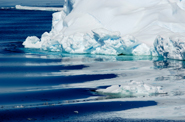11 February 2010
WASHINGTON—Depicting a cause-and-effect scenario that spans thousands of miles, scientists report that ocean waves originating along the Pacific coasts of North and South America impact Antarctic ice shelves and could play a role in their catastrophic collapse.

In a recently published study, researchers describe how storms over the North Pacific Ocean may be transferring enough wave energy to destabilize Antarctic ice shelves. The study appeared on January 29 in Geophysical Research Letters a journal of the American Geophysical Union, or AGU.
Storm-driven ocean swells travel across the Pacific Ocean and break along the coastlines of North and South America, where they are transformed into very long-period ocean waves called “infragravity waves”, according to Peter Bromirski, of the Scripps Institution of Oceanography in La Jolla, Calif., lead author of the new study. The transformed waves then travel vast distances to Antarctica.
Bromirski and his coauthors Olga Sergienko of Princeton University and Douglas MacAyeal of the University of Chicago, propose that the southbound travelling infragravity waves “may be a key mechanical agent that contributes to the production and/or expansion of the pre-existing crevasse fields on ice shelves,” and that the infragravity waves also may provide the trigger necessary to initiate the collapse process.
The researchers used seismic data collected on the Ross Ice Shelf to identify signals generated by infragravity waves that originated along the Northern California and British Columbia coasts, and modeled how much stress an ice shelf suffers in response to infragravity wave impacts. Bromirski said only recently has technology advanced to allow scientists to deploy seismometers for the extended periods on the ice shelf needed to capture such signals.
The study found that each of the Wilkins Ice Shelf breakup events in 2008 coincided with the estimated arrival of infragravity waves. The authors note that such waves could affect ice shelf stability by opening crevasses, reducing ice integrity through fracturing, and initiating a collapse. “(Infragravity waves) may produce ice-shelf fractures that enable abrupt disintegration of ice shelves that are also affected by strong surface melting,” the authors note in the paper.
Whether increased infragravity wave frequency and energy induced by heightened storm intensity associated with climate change ultimately contribute to or trigger ice shelf collapse is an open question at this point, said Bromirski. More data from Antarctica are needed to make such a connection, he said.
The California Department of Boating and Waterways and the National Science Foundation funded the infragravity wave study.
Joint Release
American Geophysical Union and Scripps Institution of Oceanography
Mario Aguilera or Annie Reisewitz,
Scripps Contacts +1 (858) 534-3624 [email protected]
Journalists and public information officers (PIOs) of educational and scientific institutions who have registered with AGU can download a PDF copy of this paper.
Or, you may order a copy of the paper by emailing your request to Maria-José Viñas at [email protected] or to Mario Aguilera or Annie Reisewitz at [email protected]. Please provide your name, the name of your publication, and your phone number.
Neither the paper nor this press release are under embargo.
<h3Images
Scripps has issued a version of this release, with images available upon request to reporters.
““Transoceanic infragravity waves impacting Antarctic ice shelves””
Peter D. Bromirski: Scripps Institution of Oceanography, University of California, San Diego, La Jolla, California, USA
Olga V. Sergienko: AOS Program, Princeton University, Princeton, New Jersey, USA
Douglas R. MacAyeal: Department of the Geophysical Sciences, University of Chicago, Chicago, Illinois, USA
Peter Bromirski, Associate Project Scientist, Tel. +1 (858) 822-0552, Email: [email protected]